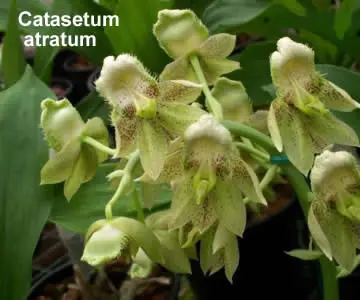 |
||
| Catasetum
A south American genus, there are some 70 species stretching from Mexico down to Argentina and the West Indies. They prefer well drained pots or baskets packed with Spagnum. The flowers are produced from the bottom of the pseudobulbs which are deciduous. |
||
| Catasetum atratum This species is endemic to the cooler southern parts of Brazil, so it does well with cool night time temperatures. The plant produces multiple spikes with lots of strongly scented flowers which are about 40mm aross. |
||
| /\ Top of Page | ||
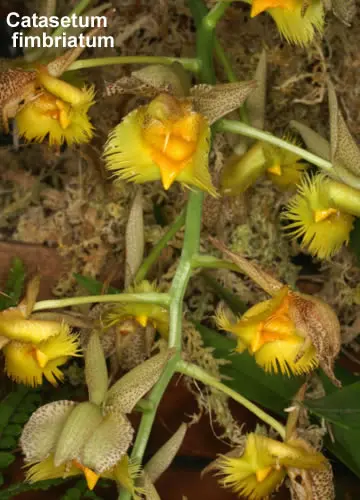 |
||
| Catasetum
A south American genus, there are some 70 species stretching from Mexico down to Argentina and the West Indies. They prefer well drained pots or baskets packed with Spagnum. The flowers are produced from the bottom of the pseudobulbs which are deciduous. |
||
| Catasetum fimbriatum Native to Bolivia, a warm growing epiphyte that needs winter rest. Keep well watered and fertilised during growth in spring/summer. Flowers all summer. |
||
| /\ Top of Page | ||
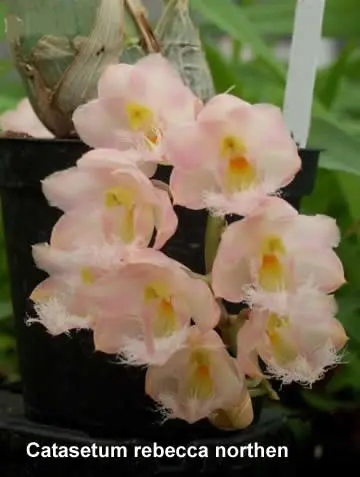 |
||
| Catasetum
A south American genus, there are some 70 species stretching from Mexico down to Argentina and the West Indies. They prefer well drained pots or baskets packed with Spagnum. The flowers are produced from the bottom of the pseudobulbs which are deciduous. |
||
| Catasetum rebecca northen Clowesia (Catasetum) Rebecca Northen is a particularly beautiful and fragrant hybrid. The inflorescences emerge from the base of the pseudobulbs and are sharply pendent unlike the more arching, pendant inflorescences of Catasetum. |
||
| /\ Top of Page | ||
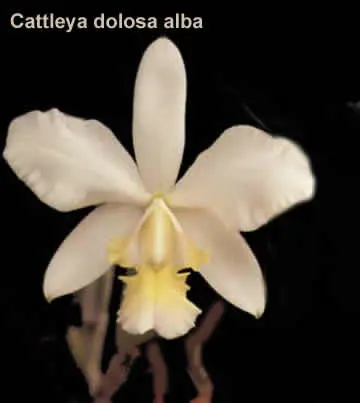 |
||
| Cattleya
From tropical America there are some 48 species of this important genus, which is the base of many man made hybrids. Most can be cultivated in intermediate conditions with plenty of water in the growing season. In their native environment they are epiphytic and live near the tops of tall trees in wet tropical forests. |
||
| Cattleya dolosa alba Believed to be a hybrid between C. loddigesii |
||
| /\ Top of Page | ||
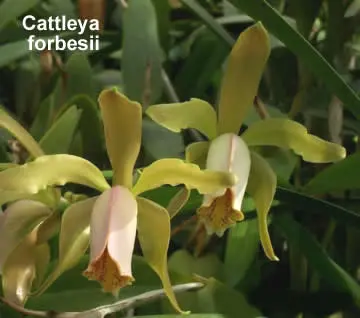 |
||
| Cattleya
From tropical America there are some 48 species of this important genus, which is the base of many man made hybrids. Most can be cultivated in intermediate conditions with plenty of water in the growing season. In their native environment they are epiphytic and live near the tops of tall trees in wet tropical forests. |
||
| Cattleya forbesii From the coastal forests of Brazil (Rio de Janeiro to Santa Catarina). The pseudobulbs average about 15cm high, the flowers are held well, usually 5 per inflorescence, and 6-8cm across. Grow seasily under intermediate conditions and often flower several times during the spring and summer. |
||
| /\ Top of Page | ||
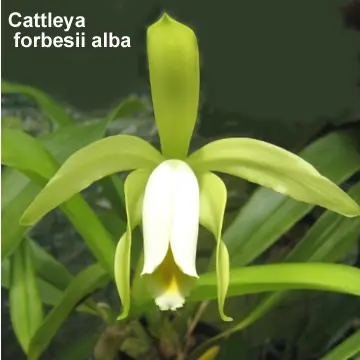 |
||
| Cattleya
From tropical America there are some 48 species of this important genus, which is the base of many man made hybrids. Most can be cultivated in intermediate conditions with plenty of water in the growing season. In their native environment they are epiphytic and live near the tops of tall trees in wet tropical forests. |
||
| Cattleya forbesii alba From the coastal forests of Brazil (Rio de Janeiro to Santa Catarina). The pseudobulbs average about 15cm high, the flowers are held well, usually 5 per inflorescence, and 6-8cm across. Grow seasily under intermediate conditions and often flower several times during the spring and summer. |
||
| /\ Top of Page | ||
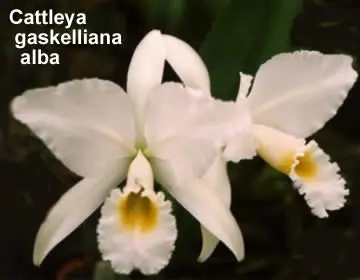 |
||
| Cattleya
From tropical America there are some 48 species of this important genus, which is the base of many man made hybrids. Most can be cultivated in intermediate conditions with plenty of water in the growing season. In their native environment they are epiphytic and live near the tops of tall trees in wet tropical forests. |
||
| Cattleya gaskelliana alba native to Venezuela, where it grows as an epiphyte and lithophyte from 2,300 to 3,300 feet above sea level in the Eastern Coastal Mountain Range, the Cordillera de la Costa. Its natural habitats vary from tropical, humid cloud forests, to growing on rocks in nearly full sun. It is easy to grow, very free flowering, and had large 18cm flowers with a nice fragrance and lovely delicate texture. it flowers late May into June on newly matured growth. |
||
| /\ Top of Page | ||
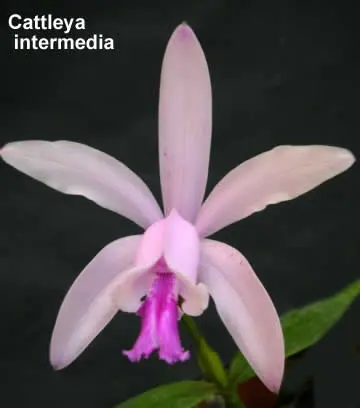 |
||
| Cattleya
From tropical America there are some 48 species of this important genus, which is the base of many man made hybrids. Most can be cultivated in intermediate conditions with plenty of water in the growing season. In their native environment they are epiphytic and live near the tops of tall trees in wet tropical forests. |
||
| Cattleya intermedia A coastal species found in southern Brazil down Uruguay and Argentina. A bifoliate of compact growth habit. Flowers are quite large 12cm in comparison with the size of the plants and are produced in fairly large (3-6 or more) number by inflorescence. In the wild the plants are subject to extreme cold and warm temperatures throughout the year, thus the plants very easy to cultivate under varied conditions. |
||
| /\ Top of Page | ||
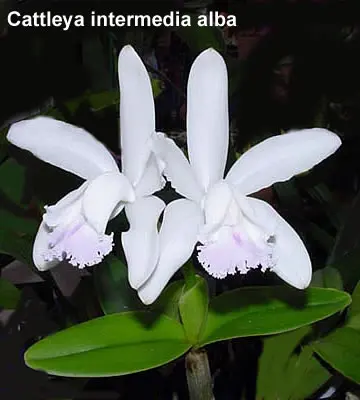 |
||
| Cattleya
From tropical America there are some 48 species of this important genus, which is the base of many man made hybrids. Most can be cultivated in intermediate conditions with plenty of water in the growing season. In their native environment they are epiphytic and live near the tops of tall trees in wet tropical forests. |
||
| Cattleya intermedia alba A coastal species found in southern Brazil down Uruguay and Argentina. A bifoliate of compact growth habit. Flowers are quite large 12cm in comparison with the size of the plants and are produced in fairly large (3-6 or more) number by inflorescence. In the wild the plants are subject to extreme cold and warm temperatures throughout the year, thus the plants very easy to cultivate under varied conditions. |
||
| /\ Top of Page | ||
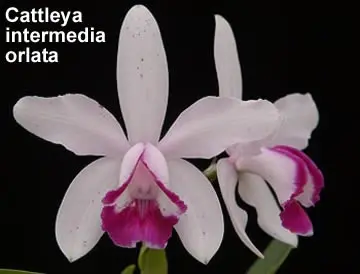 |
||
| Cattleya
From tropical America there are some 48 species of this important genus, which is the base of many man made hybrids. Most can be cultivated in intermediate conditions with plenty of water in the growing season. In their native environment they are epiphytic and live near the tops of tall trees in wet tropical forests. |
||
| Cattleya intermedia orlata A coastal species found in southern Brazil down Uruguay and Argentina. A bifoliate of compact growth habit. Flowers are quite large 12cm in comparison with the size of the plants and are produced in fairly large (3-6 or more) number by inflorescence. In the wild the plants are subject to extreme cold and warm temperatures throughout the year, thus the plants very easy to cultivate under varied conditions. |
||
| /\ Top of Page | ||
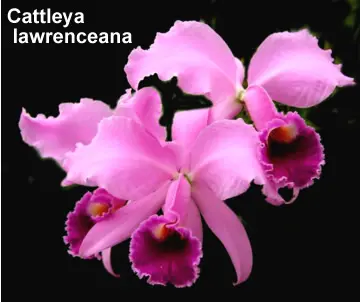 |
||
| Cattleya
From tropical America there are some 48 species of this important genus, which is the base of many man made hybrids. Most can be cultivated in intermediate conditions with plenty of water in the growing season. In their native environment they are epiphytic and live near the tops of tall trees in wet tropical forests. |
||
| Cattleya lawrenceana Native to the Gran Sabana area of eastern Venzuela, where Venezuela borders Brazil and Guyana. It has been found on all sides of this border, but Venezuela is its principal habitat. The plants grow in forested areas, usually near streams or rivers, and are most abundant at elevations between 1,200 and 4,00 feet above sea level. It is a compact plant that flowers in spring after a dormant winter rest. |
||
| /\ Top of Page | ||
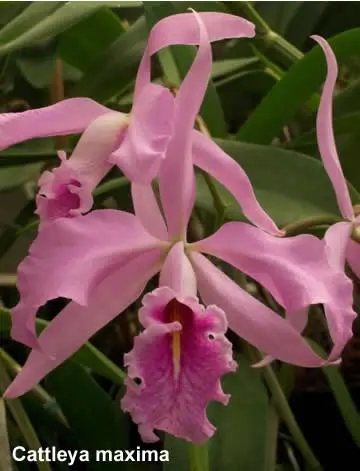 |
||
| Cattleya
From tropical America there are some 48 species of this important genus, which is the base of many man made hybrids. Most can be cultivated in intermediate conditions with plenty of water in the growing season. In their native environment they are epiphytic and live near the tops of tall trees in wet tropical forests. |
||
| Cattleya maxima From the quinine forests of what is now Peru and Ecuador and growing up to 60cm tall, maxima flowers from mid-November to early December.Grown in intermediate conditions in clay pots. |
||
| /\ Top of Page | ||
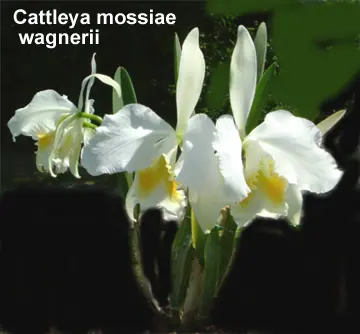 |
||
| Cattleya
From tropical America there are some 48 species of this important genus, which is the base of many man made hybrids. Most can be cultivated in intermediate conditions with plenty of water in the growing season. In their native environment they are epiphytic and live near the tops of tall trees in wet tropical forests. |
||
| Cattleya mossiae wagnerii A native Venezuela this unifoliate cattleya is the easiest species to grow, the easiest to flower, and it adapts well to more adverse growing conditions than any other species in the genus. It blooms in abundance during the months of March, April and May, give lots of water while actively growing in the summer and early autumn, and then watered sparingly during the cold winter months when it is dormant. |
||
| /\ Top of Page | ||
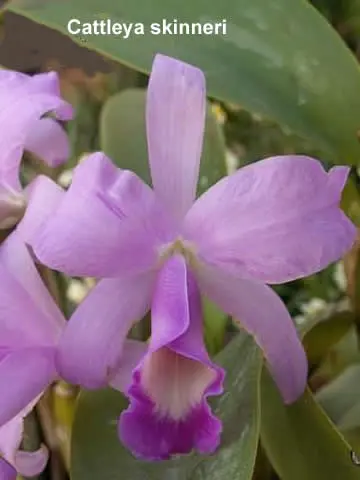 |
||
| Cattleya
From tropical America there are some 48 species of this important genus, which is the base of many man made hybrids. Most can be cultivated in intermediate conditions with plenty of water in the growing season. In their native environment they are epiphytic and live near the tops of tall trees in wet tropical forests. |
||
| Cattleya skinneri Native to Central America, where it thrives in wet mountain forests from just above sea level to about 4,000 feet (1,220 m). Its growing range begins in southern Mexico and extends through Guatemala and Honduras into El Salvador, Nicaragua and Costa Rica. It is one of the most common orchids found in Costa Rica and is so popular there, it has been named Costa Rica |
||
| /\ Top of Page | ||
 |
||
| Cattleya
From tropical America there are some 48 species of this important genus, which is the base of many man made hybrids. Most can be cultivated in intermediate conditions with plenty of water in the growing season. In their native environment they are epiphytic and live near the tops of tall trees in wet tropical forests. |
||
| Cattleya warneri A native of Brazil, this flowers in May. It needs a warm, moist atmosphere when growing. It requires a day temperature of 85 F even in the winter, when it still actively grows. A well-flowered C. warneri will produce at least four flowers on a spike, and five flowers is not unusual. Be carefull after the buds form, High temperatures are not desirable , and intense sunlight can kill them. |
||
| /\ Top of Page | ||
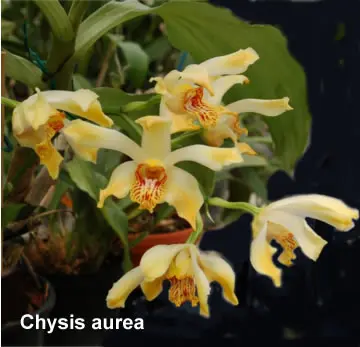 |
||
| Chysis
A small genus of 5 species from Brazil down to Peru. The plants being epiphytic grow on tree trunks in shady damp habitats. Relatively easy to grow at in intermediate conditions, they are best grown in baskets from where the long flower spikes can trail. |
||
| Chysis aurea Native to Venezuela, Colombia, and Panama. Plants are normally found at lower elevations in dense, moist forests where they grow high up in tall trees, mainly on the trunks or the basal part of large branches. Plants grow well in hanging pots or baskets that allow the growths to hang naturally . These large plants, have 6-12 long-stalked, waxy, long-lived, fragrant blossoms that are produced on each inflorescence. Water should be reduced in winter, but they should not be allowed to remain dry for long periods. |
||
| /\ Top of Page | ||
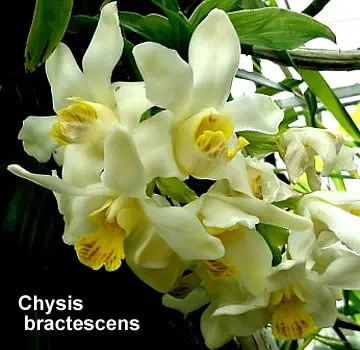 |
||
| Chysis
A small genus of 5 species from Brazil down to Peru. The plants being epiphytic grow on tree trunks in shady damp habitats. Relatively easy to grow at in intermediate conditions, they are best grown in baskets from where the long flower spikes can trail. |
||
| Chysis bractescens Found from Mexico to Nicaragua this Spring flowering orchid is deciduous, and after the leaves fall the plant should be dried out, with just sufficient water to prevent shrivelling of the bulbs. A repot into fresh media when new leads appear will promote robust growth and flowers. Because of the pendant nature of the deciduous pseudobulbs grow Chysis in a basket or mounted on a tree fern or cork slab. Provide ample water and fertilizer when in active growth and withold both during winter months. Moderate light and intermediate temperatures. |
||
| /\ Top of Page | ||
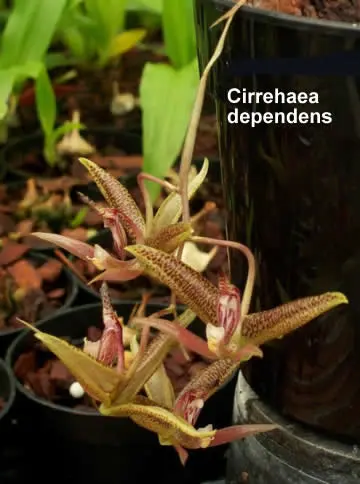 |
||
| Cirrhaea 6 species found only in Brazil. Epiphytes from the tropical rain forest, the pseudobulbs are heavily ribbed and the multiflowered inflorences appear at the base. |
||
| Cirrhaea dependens The flowers of this species do not appear to open fully. The base colour varies from bright green to brown, and spotted orange red. Grow in intermediate conditions, watering should be reduced during winter, just enough to stop the pseudobulbs becoming wrinkled. The main peak of flowering occurs between March-June. |
||
| /\ Top of Page | ||
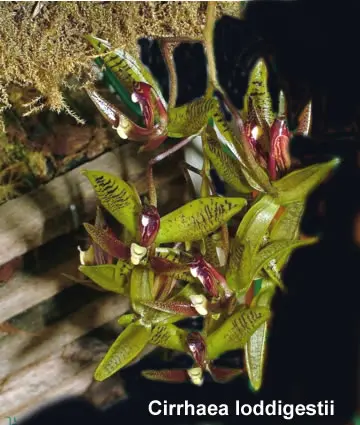 |
||
| Cirrhaea 6 species found only in Brazil. Epiphytes from the tropical rain forest, the pseudobulbs are heavily ribbed and the multiflowered inflorences appear at the base. |
||
| Cirrhaea loddigesii From central Brazil. The base colour varies from light green to brown, and spotted red-brown. Grow in intermediate conditions, watering should be reduced during winter, just enough to stop the pseudobulbs becoming wrinkled. The main peak of flowering occurs between March-June. |
||
| /\ Top of Page | ||
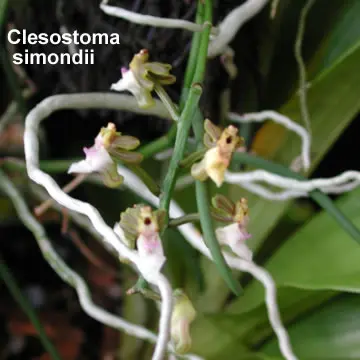 |
||
| Cleisostoma A small genus from south east Asia. Easy to grow, mount the plants on a cork support, and provide them with bright light and warmth ,complemented with frequent watering during growth. Reduce temperature and watering frequency in the winter . |
||
| Cleisostoma simondii Blooms between October and November this species is native to Thailand and other countries in southern Asia. |
||
| /\ Top of Page | ||